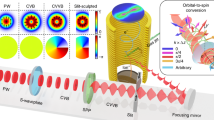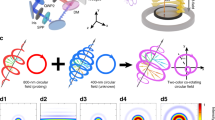Abstract
Larmor precession of a quantum mechanical angular momentum vector about an applied magnetic field forms the basis for a range of magnetic resonance techniques, including nuclear magnetic resonance spectroscopy and magnetic resonance imaging. We have used a polarized laser pump–probe scheme with velocity-map imaging detection to visualize, for the first time, the precessional motion of a quantum mechanical angular momentum vector. Photodissociation of O2 at 157 nm provides a clean source of fast-moving O(1D2) atoms, with their electronic angular momentum vector strongly aligned perpendicular to the recoil direction. In the presence of an external magnetic field, the distribution of atomic angular momenta precesses about the field direction, and polarization-sensitive images of the atomic scattering distribution recorded as a function of field strength yield ‘time-lapse-photography’ style movies of the precessional motion. We present movies recorded in various experimental geometries, and discuss potential consequences and applications in atmospheric chemistry and reaction dynamics.
This is a preview of subscription content, access via your institution
Access options
Subscribe to this journal
Receive 12 print issues and online access
$259.00 per year
only $21.58 per issue
Buy this article
- Purchase on Springer Link
- Instant access to full article PDF
Prices may be subject to local taxes which are calculated during checkout





Similar content being viewed by others
References
Bernath, P. F. Spectra of Atoms and Molecules (Oxford Univ. Press, 1995).
Wayne, R. P. Chemistry of Atmospheres 2nd edn (Oxford Univ. Press, 1990).
Rettner, C. T. & Zare, R. N. Effect of atomic reagent approach geometry on reactivity—reactions of aligned Ca(1P1) with HCl, Cl2 and CCl4 . J. Chem. Phys. 77, 2416–2429 (1982).
Janssen, M. H. M., Parker, D. H. & Stolte, S. Steric effects on electronically excited product channels in reactions between Ca(1D2) and CH3X(JKM) (X = Cl, Br). J. Phys. Chem. 100, 16066–16071 (1996).
Zare, R. N. Angular Momentum: Understanding Spatial Aspects in Chemistry and Physics (John Wiley & Sons, 1988).
Wu, S.-M. et al. Angular momentum polarisation in the O(1D) products of O2 photolysis via the B(3Σu−) state. Mol. Phys. 108, 1145–1157 (2010).
Rakitzis, T. P. & Zare, R. N. Photofragment angular momentum distributions in the molecular frame: determination and interpretation. J. Chem. Phys. 110, 3341–3350 (1999).
Parker, D. H. Laser photochemistry of molecular oxygen. Acc. Chem. Res. 33, 563–571 (2000).
Eppink, A. T. J. B., Parker, D. H., Jansenn, M. H. M., Buijsse, B. & van der Zande, W. J. Production of maximally aligned O(1D) atoms from two-step photodissociation of molecular oxygen. J. Chem. Phys. 108, 1305–1308 (1998).
Lambert, H. M., Dixit, A. A., Davis, E. W. & Houston, P. L. Quantum yields for product formation in the 120–130 nm photodissociation of O2, J. Chem. Phys. 121, 10437–10446 (2004).
Singer, S. J., Freed, K. F. & Band, Y. B. Theory of diatomic molecule photodissociation—electronic angular momentum influence on fragment and fluorescence cross-sections. J. Chem. Phys. 79, 6060–6085 (1983).
Treffers, M. A. & Korving, J. Precession induced modulation of fluorescence. J. Chem. Phys. 85, 5076–5084 (1986).
Yan, H. & Lazarian, A. Optical polarization from aligned atoms as a new diagnostic of astrophysical magnetic fields. In Conference Series, Astronomical Polarimetry: Current Status and Future Directions (eds Adamson, A., Aspin, C. & Davis, C.) Vol. 343, 346–351 (Astronomical Society of the Pacific, 2005).
Dylewski, S. M., Geiser, J. D. & Houston, P. L. The energy distribution, angular distribution, and alignment of the O(1D2) fragment from the photodissociation of ozone between 235 and 305 nm. J. Chem. Phys. 115, 7460–7473 (2001).
Chowdhury, A. M. S. Studies on the competing collisional relaxation dynamics of superthermal O(1D) atoms in the upper atmosphere by ultraviolet laser spectroscopy. Laser Phys. 9, 959–989 (1999).
Zare, R. N. Laser control of chemical reactions. Science 279, 1875–1879 (1998).
Brouard, M., Lambert, H. M., Short, J. & Simons, J. P. Product state-resolved stereodynamics of the reaction O(1D) + CH4 → OH + CH3 . J. Phys. Chem. 99, 13571–13581 (1995).
Lin, J. J., Shu, J., Lee, Y. T. & Yang, X. Multiple dynamical pathways in the O(1D) + CH4 reaction: a comprehensive crossed beam study. J. Chem. Phys. 113, 5287–5301 (2000).
Acknowledgements
The authors acknowledge support from the European Union under training network ITN 238671 ‘ICONIC’, the European Research Council under Starting Independent Research Grant 200733 ‘ImageMS’, the Dutch National Science Foundation FOM-NWO program Molecular Atmospheric Processes, and the National Science Foundation under NSF CHE 0650414.
Author information
Authors and Affiliations
Contributions
D.P., W.Z. and, independently, R.Z., conceived and designed the experiments. S.W. and D.R. performed the experiments. C.V. and G.G. analysed the data. C.V., D.P. and S.W. wrote the manuscript, with contributions from W.Z., G.G. and R.Z.
Corresponding authors
Ethics declarations
Competing interests
The authors declare no competing financial interests.
Supplementary information
Supplementary information
Supplementary information (PDF 329 kb)
Supplementary information
Supplementary Movie S1 (MOV 341 kb)
Supplementary information
Supplementary Movie S2 (MOV 249 kb)
Supplementary information
Supplementary Movie S3 (MOV 209 kb)
Supplementary information
Supplementary Movie S4 (MOV 371 kb)
Supplementary information
Supplementary Movie S5 (MOV 310 kb)
Supplementary information
Supplementary Movie S6 (MOV 224 kb)
Rights and permissions
About this article
Cite this article
Wu, SM., Radenovic, D., van der Zande, W. et al. Control and imaging of O(1D2) precession. Nature Chem 3, 28–33 (2011). https://doi.org/10.1038/nchem.929
Received:
Accepted:
Published:
Issue Date:
DOI: https://doi.org/10.1038/nchem.929



